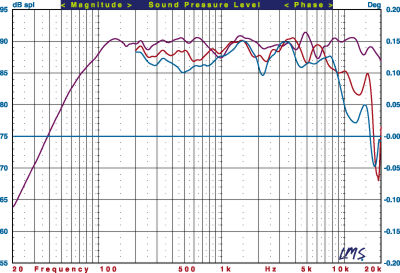Revel Performa F50 surround speaker system Measurements
Unlike most of our speaker measurements, those taken of the F50 and C50 were made with their grilles in place. The responses of both speakers with their grilles removed were slightly smoother than the curves shown, but the variations were within ±1dB.
The Revel F50's impedance, measured with its High Frequency Level control set to "0," is typical of a ported enclosure tuned to approximately 30Hz, with a minimum impedance of 3ohms at 28Hz and the same at 270Hz. The impedance phase angle is highly capacitive at 28Hz and continues to increase at lower frequencies. The impedance remains below 4ohms from 45Hz to 120Hz and from 180Hz to 425Hz. I rate its nominal impedance at 4ohms. These results suggest that the F50 might be a relatively difficult load, though during the break-in period the modestly priced Outlaw 1050 receiver had no problem driving it. The F50's sensitivity is about 86dB/W/m.
The F50's horizontal front response is shown in Fig.1 (violet). This is the pseudo-anechoic response averaged over a 30° forward horizontal angle, at tweeter height, combined with the nearfield responses of the woofers and port. The bass holds up strongly to below 30Hz, falling off rapidly below 28Hz to an effective lower limit (-10dB) of about 20Hz.

Fig.1: Revel F50, pseudo-anechoic response off horizontal axis at 45° (red) and 60° (blue).
(All figures: Violet curve: pseudo-anechoic response on tweeter axis, averaged across a 30° horizontal window, combined with nearfield woofer (and, in the F50, the port) response. All measurements taken at 1m.)
The overall 30° front horizontal response of the F50 is outstandingly smooth, with only a modest bump at around 100Hz—trivial compared to any room's contribution to the output of a speaker in this region—and some minor ripples further up the range. In fact, the response shown falls within a ±2dB window from 25Hz to nearly 20kHz—about as flat and extended as we've ever measured.
The off-axis response is not as impressive. If you look closely, you can see that it's up by several dB at 3-4kHz compared with the levels below and above this point. This could result in a slightly elevated room response in the low treble—which might explain the slight edginess I heard at higher playback levels. Revel did send us predicted in-room responses for both the Peforma F50 and their somewhat more expensive Ultima Studio, in which the F50 appeared slightly more elevated in the 2.5-10kHz region. That elevation is less than 2dB—but over this 2-octave range may produce, in comparison, a subtle but audible brightness.
Fig.2 shows the averaged horizontal front response (purple), this time overlaid with the vertical responses taken at +15° (red) and -15° (blue). The above-axis response shows a significant but narrow dip at 2.3kHz. On the other hand, the response slightly below the tweeter tracks the on-axis response closely, though I did notice a small increase in high-frequency openness when I listened on-axis. The curves do show an increase of 1-2dB in the output from 9kHz to 14kHz on-axis compared to 15° below, which might account for this subtle change.

Fig.2: Revel F50, pseudo-anechoic response at 15° above (red) and 15° below (blue) tweeter.
The Revel C50 center-channel's cabinet is tuned to about 40Hz. With its High Frequency Level control at "0" and its Placement Compensation switch in the Stand Mounted position, its impedance remained below 4ohms from 70 to 600Hz, with a minimum value of 3ohms at 137Hz. While its impedance phase angle is relatively benign through this range, I would rate its nominal impedance at 4ohms and would pair it only with an amplifier comfortable with loads that dip below that value. Its sensitivity measured approximately 90dB/W/m.
The C50's measured front horizontal response, taken on the tweeter axis and averaged in the same manner as described above for the F50, with the High Frequency Level control at "0" and the Placement Compensation switch set to Stand Mounted, is shown in Fig.3 (violet curve). The effective bass extension is approximately 50Hz (-10dB). Apart from a -3dB dip at 1kHz that covers only a small range and a few ripples elsewhere—none of which, judging from the listening tests, seems to be audibly significant—the overall on-axis averaged response is very smooth. The off-axis response, however, is a little more uneven, though still far superior to what we see from horizontally configured 2-way (woofer-tweeter-woofer) centers.

Fig.3: Revel C50, pseudo-anechoic response off horizontal axis at 45° (red) and 60° (blue).
Fig.4 shows the C50's vertical response at +15° (red) and -15° (blue), overlaid again with the averaged front horizontal response. There's some loss of energy around 3kHz as you move up or down and a little unevenness elsewhere, which suggest that the speaker will sound best on-axis.

Fig.4: Revel C50, pseudo-anechoic response at 15° above (red) and 15° below (blue) tweeter.
The F50's High Frequency Level control varied the response by the specified amount (±1dB at the "±1dB" setting). The "+1dB" setting of the C50's High Frequency Level control actually increased the highest frequencies by up to +2dB, while the "-1dB" position was very close to -1dB. The Stand Mounted position of the C50's Placement Compensation control provided the flattest response (as shown in Fig.3). At 170Hz, both the Flush Mounted and On Top of Monitor settings were down about 3.5dB from the Stand Mounted response. The Flush Mounted response continued to roll off rapidly below that frequency, while the bass in the On Top of Monitor setting returned to near flat at 100Hz, before rolling off at about the same rate as the Stand Mounted setting.—TJN
- Log in or register to post comments





























































